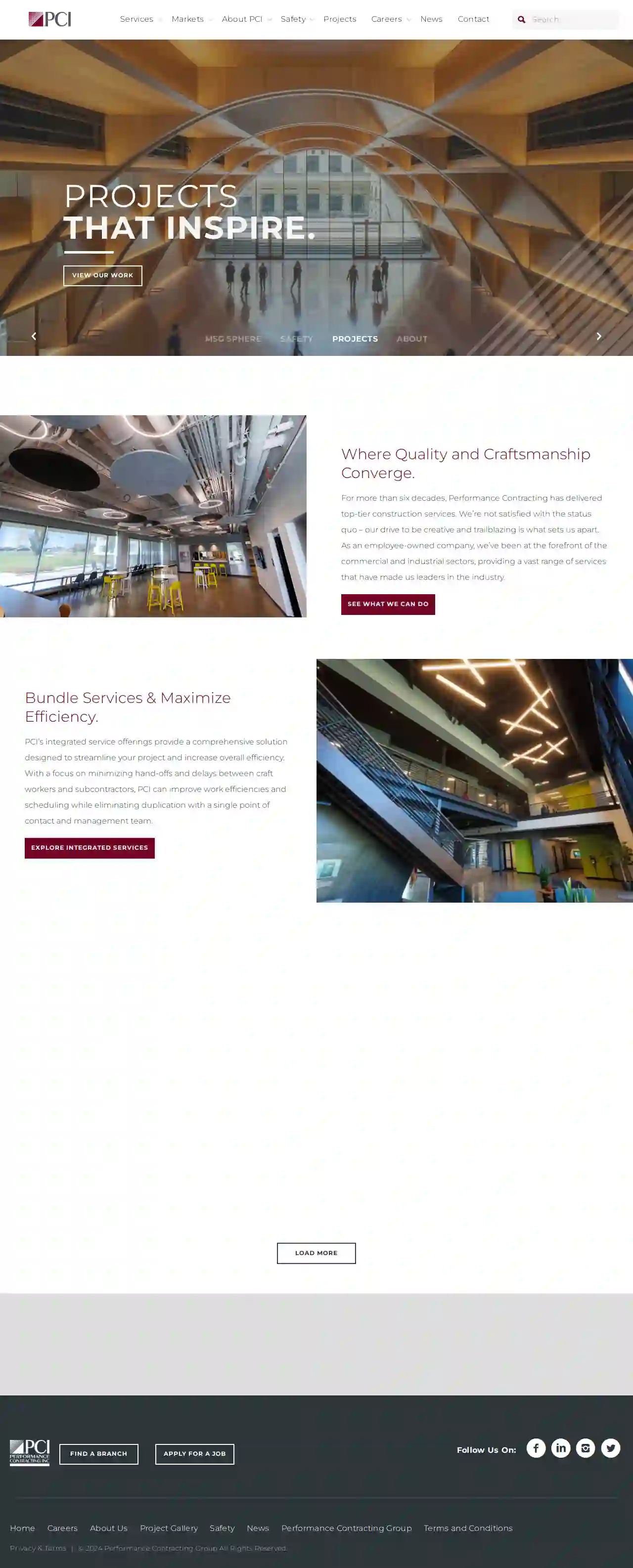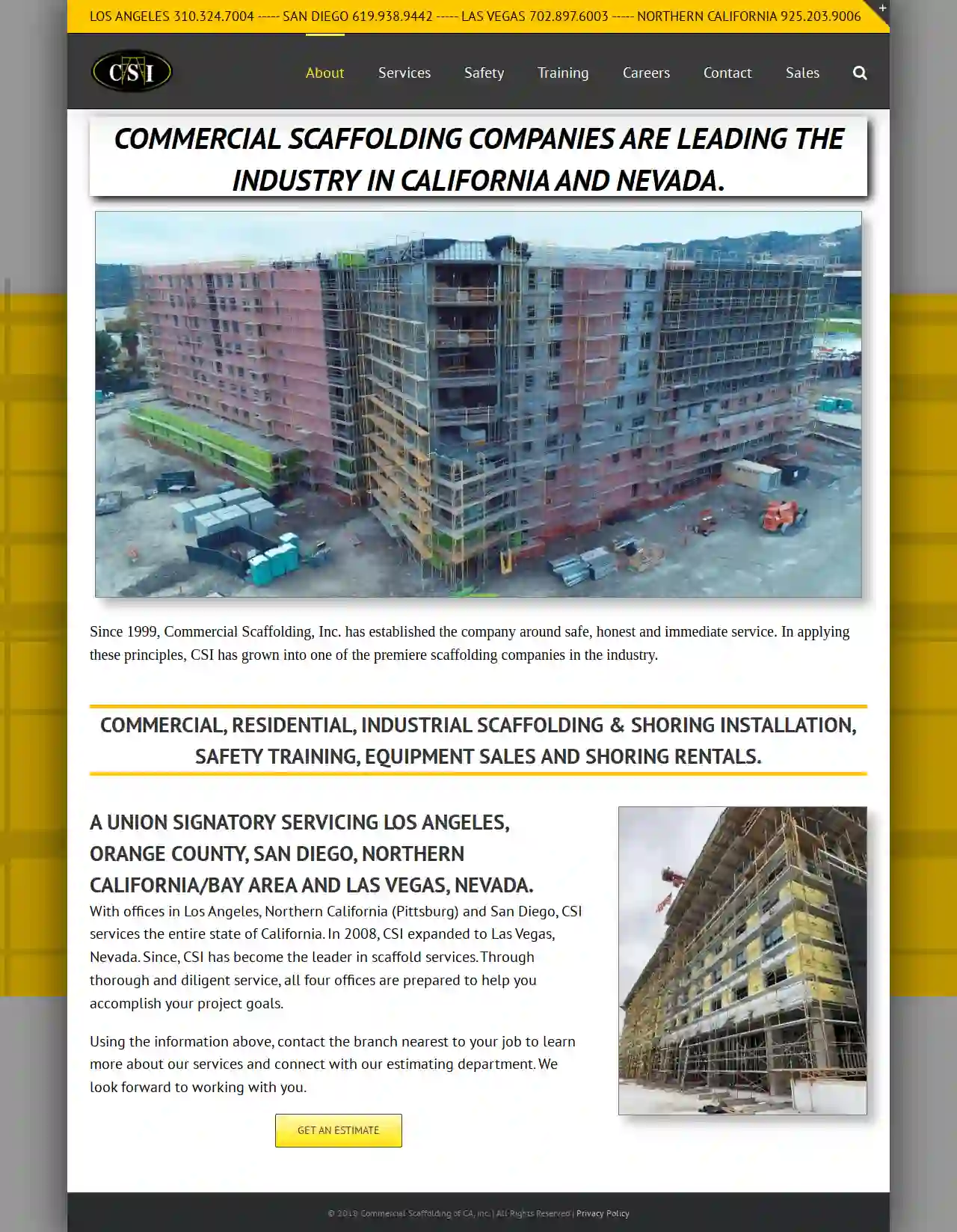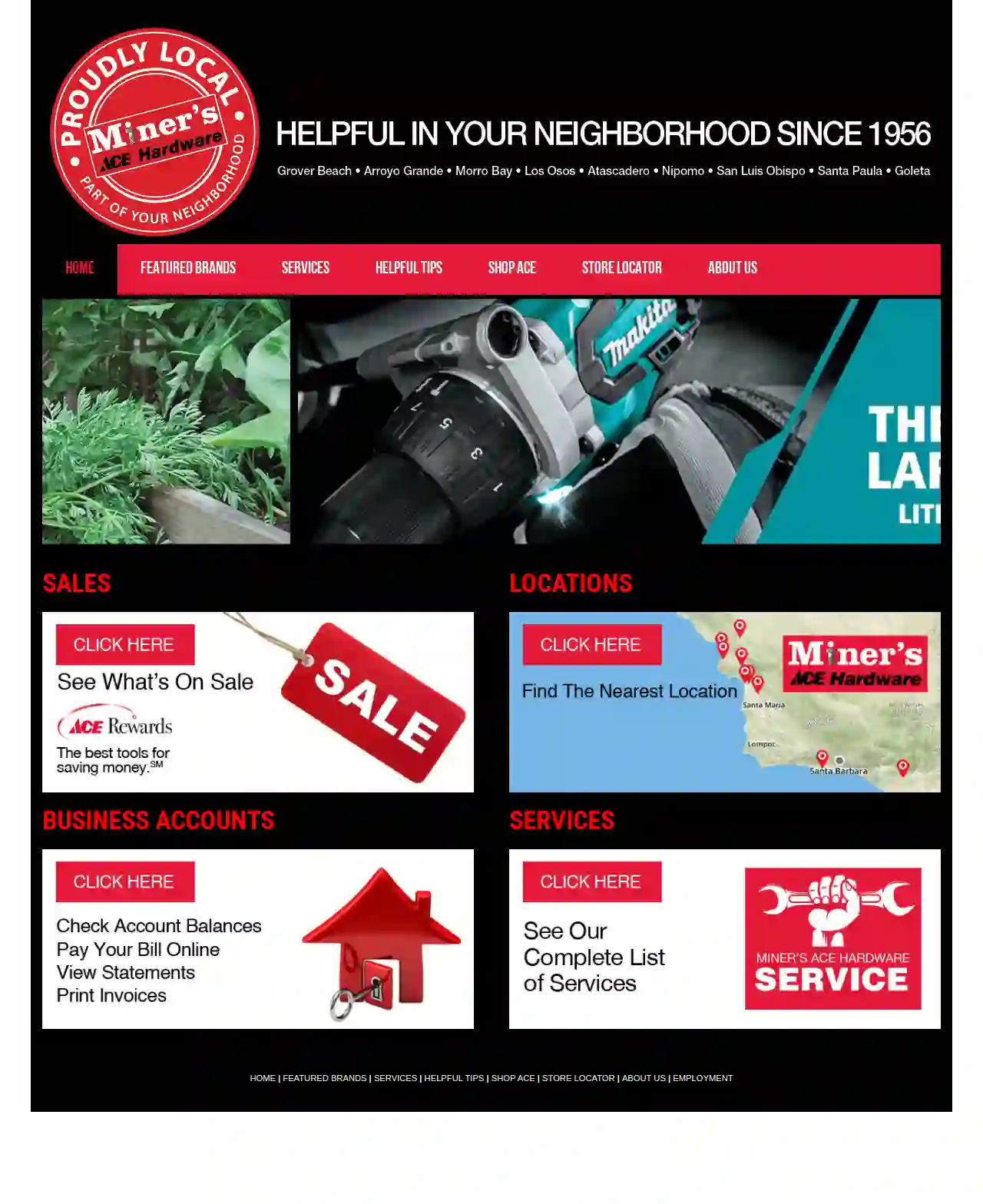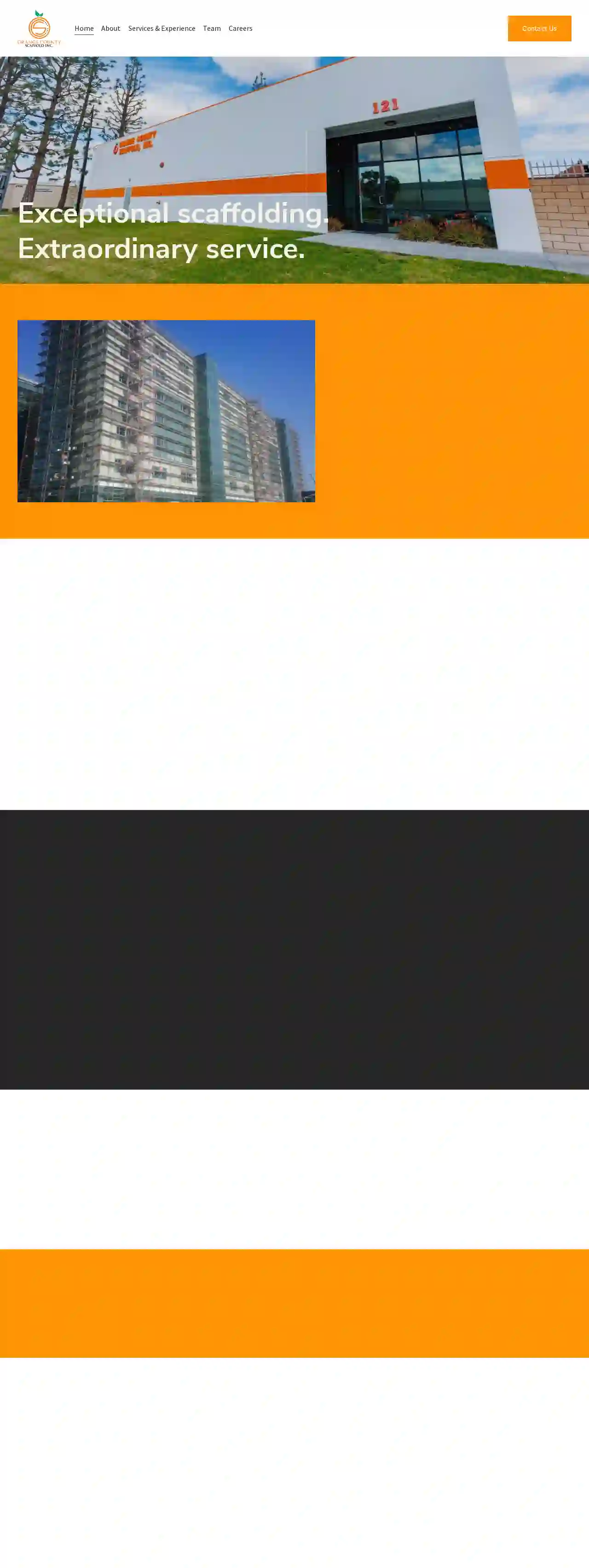Scaffolding Rental Lynwood
Find top Scaffolding Rental in Lynwood
Receive 3 FREE Scaffolding Hire quotes for your project today! Compare profiles, reviews, accreditations, portfolio, etc... and choose the best service.

PCI Scaffold & Insulation
3.65 reviews123 Main St, Springfield, IL, 12345, USPerformance Contracting, Inc. is a leading specialty contractor in the United States, offering a wide range of services and solutions tailored to the specific needs of diverse market sectors. With over 60 years of industry experience, PCI delivers top-tier construction services, focusing on minimizing hand-offs and delays between craft workers and subcontractors to improve work efficiencies and scheduling. PCI's integrated service offerings provide a comprehensive solution designed to streamline projects and increase overall efficiency.
- Services
- Why Us?
- Accreditations
- Our Team
- Testimonials
- Gallery
Get Quote
Commercial Scaffolding of CA, Inc.
4.54 reviewsLos Angeles, USAbout Commercial Scaffolding, Inc. Since 1999, Commercial Scaffolding, Inc. (CSI) has been a leading provider of scaffolding services in California and Nevada. We are committed to providing safe, honest, and immediate service to our clients. This commitment has allowed us to grow into one of the premier scaffolding companies in the industry. We offer a wide range of scaffolding and shoring services, including: Commercial scaffolding Residential scaffolding Industrial scaffolding Shoring installation Safety training Equipment sales Shoring rentals We are a union signatory and serve the following areas: Los Angeles Orange County San Diego Northern California/Bay Area Las Vegas, Nevada With offices in Los Angeles, Northern California (Pittsburg), and San Diego, CSI services the entire state of California. In 2008, CSI expanded to Las Vegas, Nevada. Since then, CSI has become the leader in scaffold services. Through thorough and diligent service, all four offices are prepared to help you accomplish your project goals. Contact the branch nearest to your job to learn more about our services and connect with our estimating department. We look forward to working with you.
- Services
- Why Us?
- Our Team
- Gallery
Get Quote
J1 Scaffolding
Higuera Road, San Jose, California, 95148, USJ1 Scaffolding is a trusted provider of commercial and residential scaffolding services in the San Francisco Bay Area and Northern California. With over 15 years of industry experience, they offer end-to-end scaffolding solutions, including planning, engineering, staging, erection, inspection, dismantle, and clean up. Their team is highly skilled and experienced, with a focus on health and safety. They are fully insured and members of the local 405 union.
- Services
- Why Us?
- Accreditations
- Our Team
- Testimonials
- Gallery
Get Quote
Commercial Scaffolding of California, Inc.
4.813 reviewsLos Angeles, USCommercial Scaffolding, Inc. (CSI) is a leading scaffolding company in California and Nevada, providing safe, honest, and immediate service since 1999. With offices in Los Angeles, Northern California, San Diego, and Las Vegas, CSI offers a range of services including commercial, residential, and industrial scaffolding and shoring installation, safety training, equipment sales, and shoring rentals. The company is a union signatory, dedicated to helping clients achieve their project goals.
- Services
- Why Us?
- Gallery
Get Quote
Miner's Ace Hardware
4.4344 reviewsSan Diego, USMiner's Ace Hardware: A Family Legacy of Service Miner's Ace Hardware is a family-owned business with a rich history dating back to 1956. Founded by brothers Lee and Glenn Miner, the company began as a small hardware store in Grover Beach, California. Driven by a commitment to hard work and customer satisfaction, the brothers built a thriving business, expanding their operations over the years to serve the Central Coast community. In 1972, Miner's joined Ace Hardware, a buying co-op that allowed them to leverage the buying power of thousands of independent dealers. This strategic alliance enabled Miner's to remain competitive and offer a wide range of products at competitive prices. Under the leadership of Mike Miner, Lee's son, the business experienced significant growth and expansion. New locations were opened in Arroyo Grande, Morro Bay, Los Osos, Atascadero, Nipomo, San Luis Obispo, Santa Paula, and Goleta, bringing the Miner's Ace Hardware experience to more communities. Today, Miner's Ace Hardware continues to be a family-owned business, guided by the same values of hard work, customer service, and community involvement that were instilled by its founders. The company is committed to providing its customers with a wide selection of products, expert advice, and friendly service.
- Services
- Why Us?
- Gallery
Get Quote
Power Scaffold Service
4.52 reviews157 East Terrance Way, Bakersfield, 93307, USAt Power Scaffold Services, we build long-lasting relationships with our clients by working closely with them to understand and anticipate their needs. We provide cost-effective solutions that enable our clients to complete their projects safely, on-time, and according to plan. Our top-notch, versatile team has erected and dismantled scaffolds for hospitals, theaters, restaurants, oil refineries, power plants, chemical plants, cement plants, and water treatment plants using our state of the art, long-lasting, and durable Cup-Lock Scaffold System.
- Services
- Why Us?
- Accreditations
- Gallery
Get Quote
BrandSafway Services Los Angeles
4.921 reviews123 BrandSafway Blvd, Los Angeles, 90001, USBrandSafway is a leading provider of access solutions, including scaffolding, aerial work platforms, and forming and shoring equipment. With a strong commitment to safety, quality, and customer satisfaction, BrandSafway offers comprehensive solutions tailored to meet the unique needs of clients across various industries. Their team of experienced professionals works closely with clients to understand their requirements and deliver customized solutions that enhance efficiency, productivity, and safety on site. BrandSafway's mission is to provide innovative access solutions that help clients achieve their goals while maintaining the highest standards of safety and quality.
- Services
- Why Us?
- Accreditations
- Our Team
- Testimonials
Get Quote
Steel City Scaffold
1234 Main St, Los Angeles, CA, 90001, USSteel City Scaffold, Inc. is a commercial and industrial scaffold company specializing in providing top-notch scaffolding solutions to clients in Central and Southern California. With a focus on safety, quality, and excellence, Steel City Scaffold offers a wide range of scaffolding accessories including Canopy, Stair Towers, Re-shoring, Handrailing, Trash Chutes, and more. As a member of the SAIA since 2010, Steel City Scaffold understands the importance of setting safe scaffolding and offers 'Scaffold Awareness Training' to ensure users working on scaffolding understand and recognize safety hazards. Steel City Scaffold, Inc. is committed to providing immediate response, quick turnaround, and excellent customer service.
- Services
- Why Us?
- Accreditations
- Our Team
- Testimonials
- Gallery
Get Quote
Orange County Scaffold Inc
3.29 reviews121 E. Meats Ave., Orange, 92865, USOC Scaffold is a leading Southern California scaffold provider with unparalleled expertise in the industrial, commercial, residential, and infrastructure sectors. For over 50 years, our family-owned business has built strong relationships within the industry, handling projects ranging from small-scale to multi-million dollar ventures. We specialize in delivering innovative scaffolding solutions, temporary access and egress, and industrial services, tailored to meet the unique needs of each project. Collaborating closely with architects, engineers, and construction professionals, we ensure flexibility, safety, and efficiency in every task. At OC Scaffold, we're more than just a service provider; we're your trusted partner in building success.
- Services
- Why Us?
- Our Team
- Testimonials
- Gallery
Get Quote
Marshall Scaffold
4.511 reviews3351 Industrial DR, Suite 3, Santa Rosa, 95403, USLeading the Northern California Scaffold industry since 1964. Certified DVBE / SBPW / SBM. Marshall Scaffold and Supply sells and rents quality scaffolding. They also have bleachers, stages and shoring structures available to rent. They offer setup and dismantling services as well. Company Philosophy “It’s very important to us to keep our word and do everything that we say that we’ll do. We have a list of ‘ten commandments’ for running a business that we live by. We realize that without customers we would not have a company, so we always put the needs of the customer first and foremost.” Our Team A Dedicated Team: Our Greatest Asset Marshall Scaffold takes great pride in its outstanding team of experts. President JUSTIN MILLER Justin Miller is a native of Sonoma county, CA. Justin entered the Scaffold Industry in 1996 after proudly serving in the United States Marine Corps.
- Services
- Why Us?
- Accreditations
- Our Team
- Testimonials
- Gallery
Get Quote
Over 2,353+ Scaffolding Contractors onboarded
Our scaffolding companies operate in Lynwood and surroundings!
ScaffoldingHQ has curated and vetted the Best Scaffolding Companies near Lynwood. Find a trustworthy pro today.
Frequently Asked Questions About Scaffolding Rental
- All Components: Ensure all the necessary components (tubes, clamps, boards, braces, etc.) are present and in good condition.
- Damage or Defects: Look for any signs of damage, rust, or defects on the scaffolding parts.
- Scaffolding Tag: Verify that the scaffolding tag is up-to-date and shows the last inspection date.
- Safety Features: Check that guardrails, toeboards, and other safety features are included and in working order.
- Small Repairs or Painting: A rolling tower or mobile scaffolding is often sufficient for smaller projects, providing a stable platform at lower heights.
- Roof Work: Roofing projects typically require taller and more robust scaffolding, like tube and clamp or system scaffolding.
- Two-Story Homes: For accessing higher levels of a two-story home, you may need a larger system scaffolding structure.
- Limited Access: If space is restricted, consider a narrow-width scaffolding tower or suspended scaffolding.
- Type of Scaffolding: Tube and clamp, system scaffolding, mobile towers, and specialized systems have different rental rates.
- Scaffolding Size and Height: Larger and taller scaffolding structures require more materials, increasing the cost.
- Rental Duration: The length of the rental period will significantly affect the price.
- Location: Rental rates can vary by location due to differences in labor costs and demand.
- Delivery and Setup: Some companies charge extra for delivery, erection, and dismantling services.
- Cost-Effective for Short-Term Projects: Renting is generally more affordable for projects that don't require scaffolding for an extended period.
- No Storage or Maintenance Costs: You don't have to worry about storing or maintaining the scaffolding after your project.
- Access to a Variety of Equipment: Rental companies offer a wide selection of scaffolding types and sizes, allowing you to choose the best fit for your project.
- Long-Term Investment: Buying makes sense if you anticipate frequent scaffolding needs over a long period.
- Customization: You can customize the scaffolding to fit your specific requirements.
- Potential Resale Value: You can potentially resell the scaffolding after you no longer need it.
What should I check for when the scaffolding is delivered?
What type of scaffolding is best for home use?
How much does it cost to rent scaffolding?
What is the difference between renting and buying scaffolding?
Renting Scaffolding:
What should I check for when the scaffolding is delivered?
- All Components: Ensure all the necessary components (tubes, clamps, boards, braces, etc.) are present and in good condition.
- Damage or Defects: Look for any signs of damage, rust, or defects on the scaffolding parts.
- Scaffolding Tag: Verify that the scaffolding tag is up-to-date and shows the last inspection date.
- Safety Features: Check that guardrails, toeboards, and other safety features are included and in working order.
What type of scaffolding is best for home use?
- Small Repairs or Painting: A rolling tower or mobile scaffolding is often sufficient for smaller projects, providing a stable platform at lower heights.
- Roof Work: Roofing projects typically require taller and more robust scaffolding, like tube and clamp or system scaffolding.
- Two-Story Homes: For accessing higher levels of a two-story home, you may need a larger system scaffolding structure.
- Limited Access: If space is restricted, consider a narrow-width scaffolding tower or suspended scaffolding.
How much does it cost to rent scaffolding?
- Type of Scaffolding: Tube and clamp, system scaffolding, mobile towers, and specialized systems have different rental rates.
- Scaffolding Size and Height: Larger and taller scaffolding structures require more materials, increasing the cost.
- Rental Duration: The length of the rental period will significantly affect the price.
- Location: Rental rates can vary by location due to differences in labor costs and demand.
- Delivery and Setup: Some companies charge extra for delivery, erection, and dismantling services.
What is the difference between renting and buying scaffolding?
Renting Scaffolding:
- Cost-Effective for Short-Term Projects: Renting is generally more affordable for projects that don't require scaffolding for an extended period.
- No Storage or Maintenance Costs: You don't have to worry about storing or maintaining the scaffolding after your project.
- Access to a Variety of Equipment: Rental companies offer a wide selection of scaffolding types and sizes, allowing you to choose the best fit for your project.
- Long-Term Investment: Buying makes sense if you anticipate frequent scaffolding needs over a long period.
- Customization: You can customize the scaffolding to fit your specific requirements.
- Potential Resale Value: You can potentially resell the scaffolding after you no longer need it.